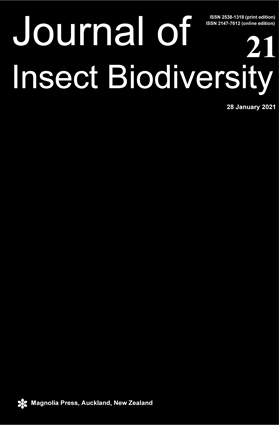Abstract
The relatively small order Dermaptera (commonly called “earwigs”) is comprised of more than 1900 described species mainly distributed in the Afrotropics, Southeastern Asia and South America, while a small number of species occur in the warmer temperate regions of North America, Europe, Asia and Australia (Hudson 1973; Popham 2000; Haas et al. 2011). In the Balkans and Turkey, this insect order is understudied and knowledge about the distribution and ecology of the earwig fauna is scattered (Haas & Henderickx 2002; Anlaş et al. 2010; Anlaş & Kočárek 2012; Muranyi 2013; Haas 2015). In Greece 16 species have been recorded so far (Haas 2015, 2018), showing greater diversity than other countries in the Balkans (Muranyi 2013). From the poorly studied North Aegean Islands, four earwig species are reported (Haas 2015), namely Anisolabis maritima (Bonelli, 1832), Forficula auricularia Linnaeus, 1758, F. lurida Fischer, 1853 and Labidura riparia (Pallas, 1773).
References
Anlaş S., Haas F. & Tezcan S. 2010. Dermaptera (Insecta) fauna of Bozdaðlar Mountain, Western Turkey. Linzer Biologischen Beiträge 42 (1): 389–399.
Anlaş S. & Kočárek P. 2012. Current status of Dermaptera (Insecta) fauna of Turkey and Cyprus. Turkish Journal of Entomology 36 (1): 43–58.
Bivar de Sousa A. & Sakai S. 1997. Dermápteros (Insecta: Dermaptera) da Macaronésia, faunística e zoogeografía. Boletim da Sociedade Portuguesa de Entomología 167: 229–244.
Haas F. 2015. Earwig Research Centre – ERC – The site on earwig biology. Available from: http://www.earwigs-online.de/GR/gr.html (Accessed 7 November 2020)
Haas F. 2018. Biodiversity of Dermaptera, pp. 315-334. In: Insect Biodiversity: Science and Society. Volume II (R.G. Foottit and P.H. Adler, editors). John Wiley & Sons Ltd., Hoboken, United States, 1024 pp.
https://doi.org/10.1002/9781118945582.ch12
Haas F. & Henderickx H. 2002. Dermaptera from Cyprus and Turkey. Beiträge zur Entomologie 52: 235–239.
https://doi.org/10.21248/contrib.entomol.52.1.235-239
Haas F., Pohl H. & Wranik W. 2004. Dermaptera of the Socotra Archipelago with the description of a new species. Fauna of Arabia 20: 409–419.
Haas F., Hwen J. T. C. & Tang H. B. 2011. New evidence on the mechanics of wing unfolding in Dermaptera (Insecta). Arthropod Systematics and Phylogeny 70 (2011): 95–105.
Hudson L. 1973. A systematic revision of the New Zealand Dermaptera. Journal of the Royal Society of New Zealand 3 (2): 219–254.
https://doi.org/10.1080/03036758.1973.10430603
Hulme P. 2009. Trade, transport and trouble: managing invasive species pathways in an era of globalization. Journal of Applied Ecology 46: 10c18.
https://doi.org/10.1111/j.1365-2664.2008.01600.x
Jacobs S. B. 2013. European earwig, Forficula auricularia, Insecta: Dermaptera. Department of Entomology, Pennsylvania State University, 2 pp.
Matzke D. 2018. Aktuell synanthrop lebende Ohrwürmer in Deutschland. Deutsche Gesellschaft für allgemeine und angewandte Entomologie - Nachrichten 32: 6–9.
Matzke D. & Kočárek P. 2015. Description and biology of Euborellia arcanum sp. nov., an alien earwig occupying greenhouses in Germany and Austria (Dermaptera: Anisolabididae). Zootaxa 3956 (1): 131–139.
https://doi.org/10.11646/zootaxa.3956.1.8
Muranyi D. 2013. Data to three insect orders (Embiidina, Dermaptera, Isoptera) from the Balkans. Opuscula Zoologica 44(1): 167–186.
Nishikawa M. & Kusui Y. 2008. Earwigs (Dermaptera) collected in airplanes and ships called at ports in Japan. Tettigonia 9: 7-11.
UNHCR 2020. Refugee Situations Operational Portal: Greece. Available from: https://data2.unhcr.org/en/situations/mediterranean/location/5179 (accessed 13 November 2020)
Popham E. 2000. The geographical distribution of the Dermaptera (Insecta) with reference to continental drift. Journal of Natural History 35: 2007–2027.
https://doi.org/10.1080/00222930050144837
Roques A., Rabitsch W., Rasplus J. Y., Lopez-Vaamonde C., Nentwig W. & Kenis M. 2009. Alien terrestrial invertebrates of Europe. In: Handbook of alien species in Europe. Springer, pp. 63–79.
https://doi.org/10.1007/978-1-4020-8280-1_5
Quarrell S. R., Arabi J., Suwalski A., Veuille M., Wirth T. & Allen G. R. 2018. The invasion biology of the invasive earwig, Forficula auricularia in Australasian ecosystems. Biological Invasions 20 (6): 1553–1565.
https://doi.org/10.1007/s10530-017-1646-3
Rasplus J. Y. & Roques A. 2010. Dictyoptera (Blattodea, Isoptera), Orthoptera, Phasmatodea and Dermaptera. Chapter 13.3. In: BioRisk. 807 pp.
https://doi.org/10.3897/biorisk.4.68
Steinmann H. 1989. World Catalogue of Dermaptera. Series Entomologica 43: 1–934.
Steinmann H. 1993. Dermaptera: Eudermaptera II. Tierreich 108, Walter de Gruyter, Berlin, New York, 709 pp.
Walker K. A. 1997. Aggregation, courtship and behavioral interactions in European earwigs, Forficula auricularia L. (Dermaptera: Forficulidae). [Unpublished doctoral dissertation]. Virginia Polytechnic Institute and State University.
Weidner H. 1974. Einschleppung von Ohrwürmern nach Deutschland (Dermaptera). Anzeiger für Schädlingskunde, Pflanzen-und Umweltschutz 47 (10): 145–148.


